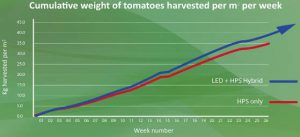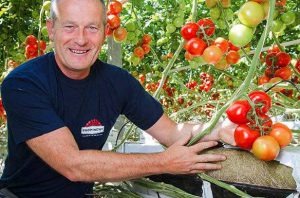The seven-month trial, managed by Plessey head agronomist Maarten Klein (right), ran from November 2016 at Gebr Koot in the Netherlands.
Brioso variety tomatoes were illuminated by either 150μmoles/s/m² of HPS or the same, but with an extra 58μmoles/s/m² of Plessey LEDs.
 “By the end of the trial, an extra yield of 9.4% (3.28kg/m²) was achieved with a slight increase in average weight per tomato for the hybrid LED/HPS installation compared to the control area with HPS lighting alone,” said Plessey. “The increase in yield was possible because the plant load allowed more fruits per truss without losing plant strength. It is likely even higher yields are achievable by increasing greenhouse temperatures to take advantage of the increased potential in the crop.”
“By the end of the trial, an extra yield of 9.4% (3.28kg/m²) was achieved with a slight increase in average weight per tomato for the hybrid LED/HPS installation compared to the control area with HPS lighting alone,” said Plessey. “The increase in yield was possible because the plant load allowed more fruits per truss without losing plant strength. It is likely even higher yields are achievable by increasing greenhouse temperatures to take advantage of the increased potential in the crop.”
According to the firm, adding LED light fixtures to existing HPS lighting system allows greater light intensity to the crop, for longer periods, with little extra heat to manage in the greenhouse.
The plants continue to get radiant heat from the HPS lights, and gain from the extra LED wavelengths – including ‘far‑red’, ‘hyper‑red’ and blue, said the firm.
The LED fixtures are at least 40% more energy efficient than the HPS fixtures.
 “At the beginning of the trial,” said grower Geert Koot (right), “the crop looked healthy in both lighting environments but with the added LED illumination, the crop was stronger with thicker stems and more dark green leaves. The first trusses under the LED lighting developed later but the plant was stronger with higher crop potential, allowing an extra fruit to be carried on each truss.”
“At the beginning of the trial,” said grower Geert Koot (right), “the crop looked healthy in both lighting environments but with the added LED illumination, the crop was stronger with thicker stems and more dark green leaves. The first trusses under the LED lighting developed later but the plant was stronger with higher crop potential, allowing an extra fruit to be carried on each truss.”
Through the trial, stem length was similar between the hybrid LED/HPS and HPS only lighting and though the average stem thickness was higher under LED/HPS from week 48 to 52, after that average thickness was comparable. Leaf length was slightly longer under HPS only with the leaves under LED/HPS being a bit more compact. The brix level in the fruit was the same.
The average amount of flowering trusses were also similar, indicating that flowering speed was unchanged and the average number of set trusses was the same, showing that pollination by bees was not affected by the LEDs.
Copyright © All Right Reserved 浙ICP备15016532号
BY: